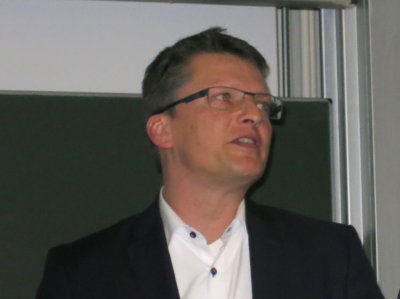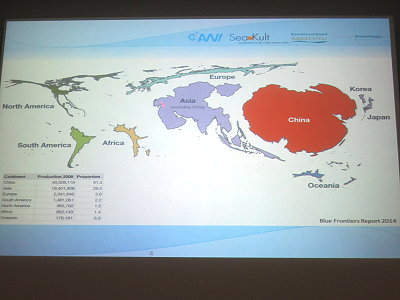Multitrophic aquaculture
 Prof. Bela Buck of the Alfred Wegener Institute for Polar and Marine Research (AWI) in Bremerhaven focused his talk on integrated multitrophic aquaculture (IMTA). Aquaculture is the production of aquatic organisms under controlled conditions. The span of cultured organisms is wide, seaweed, molluscs, crustaceans, fish and others. Europe's main aquaculture products are blue mussels, sea bass and salmon. Mussels are filterfeeders low in the food web, the fish species are carnivores much higher in the trophic web.
Prof. Bela Buck of the Alfred Wegener Institute for Polar and Marine Research (AWI) in Bremerhaven focused his talk on integrated multitrophic aquaculture (IMTA). Aquaculture is the production of aquatic organisms under controlled conditions. The span of cultured organisms is wide, seaweed, molluscs, crustaceans, fish and others. Europe's main aquaculture products are blue mussels, sea bass and salmon. Mussels are filterfeeders low in the food web, the fish species are carnivores much higher in the trophic web.
Europe plays only a modest role on the global map of aquaculture production, which is dominated by Asia, particularly China. Good environmental conditions are increasingly recognised as key for future production. Several international organisations have therefore developed guidelines to reduce the ecological footprint of aquaculture. Several approaches are under development or further refinement to combine stable production with good environmental status.
IMTA or polyculture is one such approach. An example is a combination of vegetable and fish production, where fish tank effluents water and fertilise vegetable plantation. The biggest effect is in the vegetable segment, but the combination produces less waste and has higher ecological and economic stability.
 Another example completely located in the sea is fish cultivation, such as turbot (Scophthalmus maximus) with downstream mussels (Mytilus edulis), oysters (Ostrea edulis, Crassostrea gigas) and other filter feeders and algae (e.g. Palmaria palmata, Saccharina latissima) as the final cleaning-cum-production step. The filter feeders take up the particulate matter of the waste water of fish tanks, while the macroalgae absorb the disolved nutrients.
Another example completely located in the sea is fish cultivation, such as turbot (Scophthalmus maximus) with downstream mussels (Mytilus edulis), oysters (Ostrea edulis, Crassostrea gigas) and other filter feeders and algae (e.g. Palmaria palmata, Saccharina latissima) as the final cleaning-cum-production step. The filter feeders take up the particulate matter of the waste water of fish tanks, while the macroalgae absorb the disolved nutrients.
This is a fertile field of sustainability research that can learn from traditional polyculture e.g. in China, but also from modern forms of polyculture with different site-adapted species combinations. The ultimate lynch pin is always to make it not only work in terms of good use of different ecological niches in the trophic network, but also ensure finanial viability.








